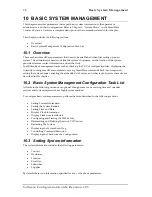
Configuration File Handling
67
As soon as a user-specific configuration is created and stored as the startup configuration, the factory
configuration is no longer used, but still remains in the persistent memory. At any time during the
operation of a SmartNode it is possible to switch back to the factory configuration. The restoration
procedure for restoring the default settings is described in the companion volume
Hardware
Installation Guide
.
9.3 Warnings
Avoid downloading any configuration file if you do not completely understand what you have to
do! If a configuration file download fails or succeeds only partially your SmartNode device cannot
start up without a support intervention at the Inalp Networks factory.
9.4 Configuration File Handling Task List
This Section describes how to create, load, and maintain configuration files. Configuration files
contain a set of user-configured commands that customize the functionality of your SmartNode
device so as to suit your own operating requirements.
The tasks in this chapter assume that you have at least a minimal configuration running on your
system. You can create a basic configuration file using the
configure
command; see Chapter 9.10,
“Modifying the Running Configuration at the CLI”, in this guide for details.
To display, copy, delete, and down- or upload configuration files perform the tasks described in the
following sections:
•
Copy Configurations within the Local Memory
•
Replacing the Startup Configuration with a Configuration from Flash Memory
•
Copy Configurations to and from a Remote Storing Location
•
Replacing the Startup Configuration with a Configuration downloaded from TFTP Server
•
Displaying Configuration File Information
•
Modifying the Running Configuration at the CLI
•
Modifying the Running Configuration Offline
•
Deleting a Specified Configuration
9.5 Copy Configurations within the Local Memory
Configuration files may be copied within the local memory in order to switch between different
configurations. Remember the different local memory regions in SmartWare as shown in Figure 9-
below.
In the majority of cases, the interactively modified running configuration known as the
running-
config,
which is to be found in the volatile memory region
system:,
is copied to the persistent memory
region
nvram:
. This running config is stored under the name
startup-config
and replaces the existing
startup configuration.
The current running configuration can be copied to the persistent memory region
nvram:
under a
user-specified name, if that configuration is to be preserved.
In addition, an already existing configuration is usually copied to the persistent memory region
nvram:
using a user-specified name, for conservation or later activation.
2
Software Configuration Guide, Revision 1.03
Summary of Contents for SmartWare R2.00
Page 2: ......
















































